What Other Beneficial Animals Does a Frog Pond Attract? A Garden’s Hidden Ecosystem
Frog ponds are amazing backyard features that attract more than just frogs. These small water bodies create mini-ecosystems that support a variety of beneficial animals.
A well-designed frog pond can attract insects, birds, small mammals, and other amphibians. All of these creatures play important roles in the local environment.
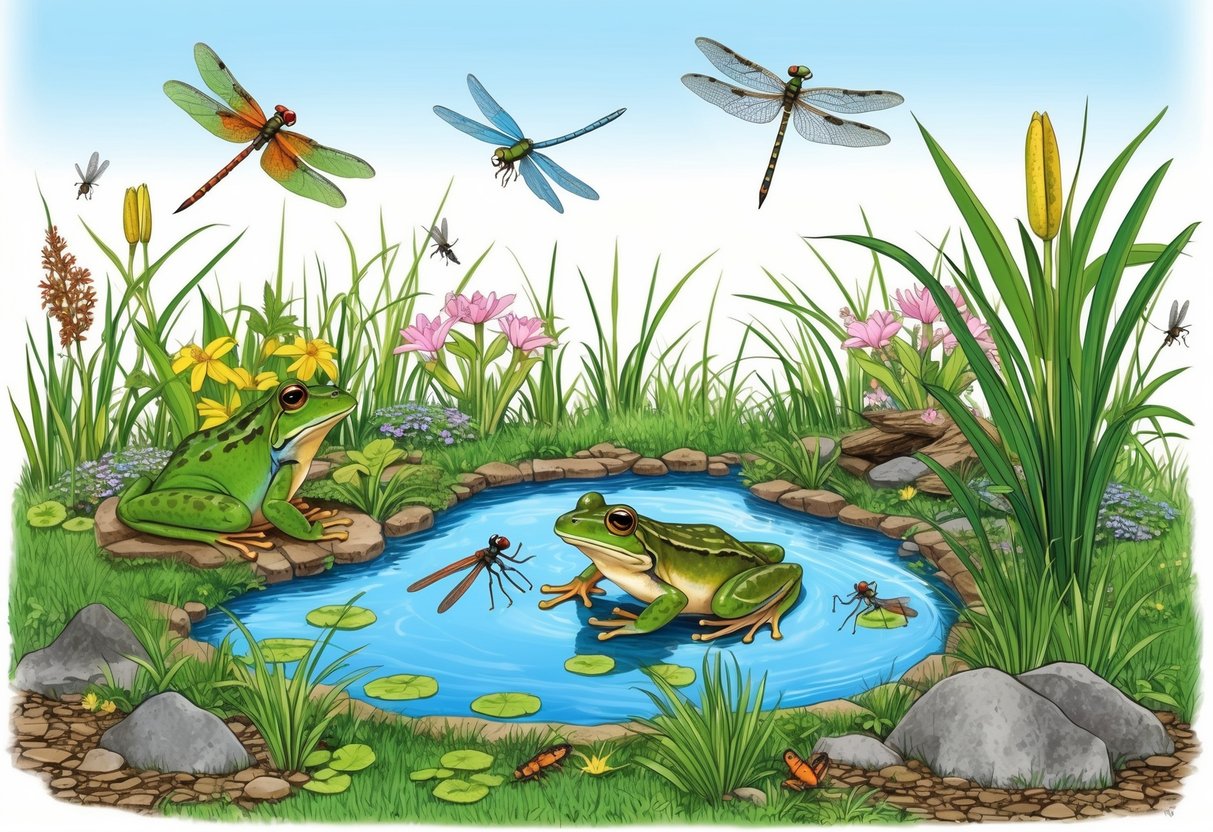
Creating a frog pond is a great way to support local wildlife. It provides a water source and habitat for many creatures.
The plants around the pond offer food and shelter. The insects drawn to the water become food for frogs, birds, and other animals.
A frog pond can help control pests in your yard. Many of the animals it attracts eat mosquitoes, slugs, and other garden pests. This natural pest control can reduce the need for harmful chemicals.
Plus, watching the pond and its visitors can be fun and relaxing for the whole family.
Key Takeaways
- Frog ponds attract a diverse range of beneficial wildlife to your backyard
- These ponds create mini-ecosystems that support local biodiversity
- Animals drawn to frog ponds can provide natural pest control for your garden
The Ecological Significance of Frog Ponds
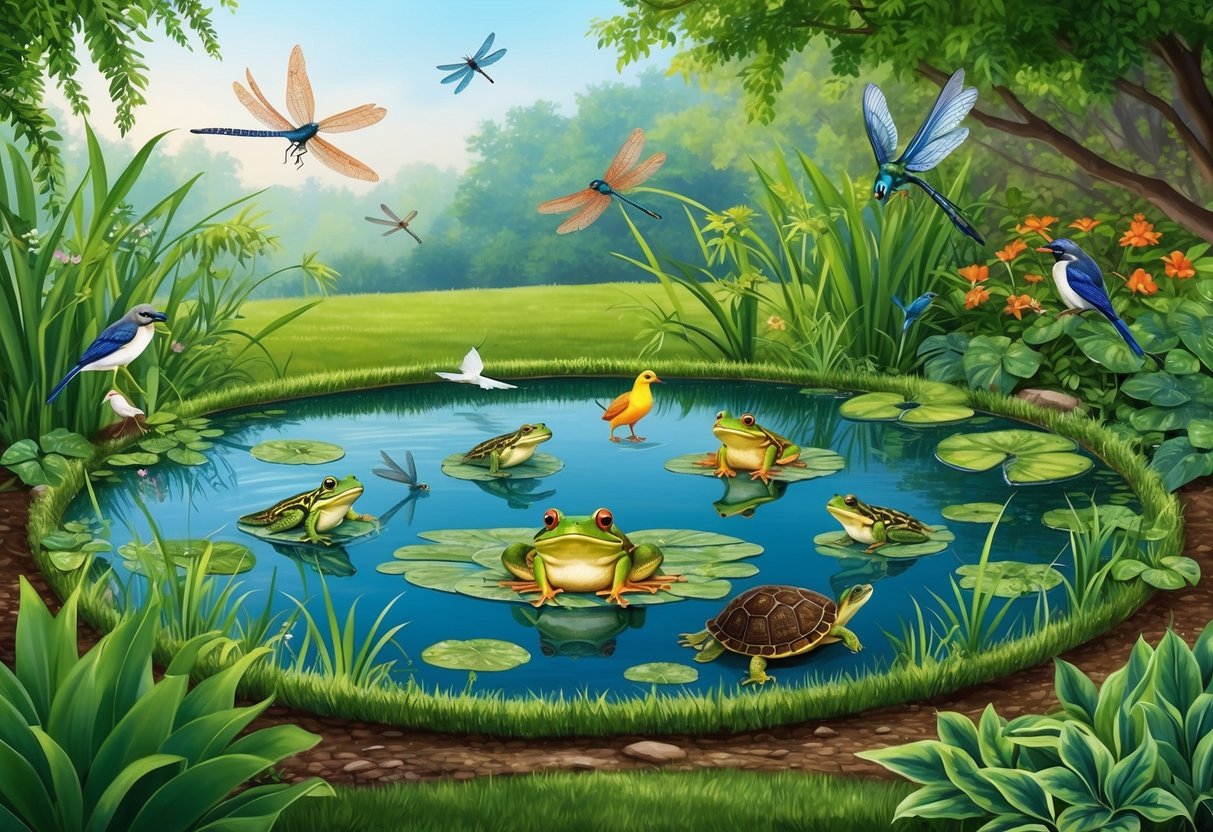
Frog ponds play a vital role in supporting diverse ecosystems. They create habitats, boost biodiversity, and help balance local environments. These ponds are much more than just homes for frogs.
Habitat Creation
Frog ponds provide homes for many creatures. They offer shelter and breeding grounds for amphibians.
Insects, birds, and small mammals also rely on these ponds.
Frog ponds can be natural or man-made. Even small backyard ponds can help wildlife. They give animals a place to drink, bathe, and cool off.
Plants grow in and around the ponds too. This greenery adds to the habitat value. It gives animals places to hide and nest.
Biodiversity Support
Frog ponds boost local biodiversity. They attract a wide range of species. This includes:
- Frogs and toads
- Dragonflies and damselflies
- Water beetles
- Aquatic plants
Many endangered freshwater species find homes in these ponds. The ponds act as stepping stones. They connect different habitats and help species move around.
Frog ponds also support land animals. Birds, bats, and other creatures feed on the insects that live there.
Ecosystem Balancing
Frog ponds help keep ecosystems in balance. Frogs play a key role in this process. They eat lots of insects, which helps control pest populations.
The ponds also help with water management. They catch and store rainwater. This can reduce flooding and erosion in the area.
Plants in the pond filter water. They remove pollutants and excess nutrients. This improves water quality for all the creatures that depend on it.
Frog ponds even affect the land around them. They create unique microclimates. These spots can be cooler and more humid than surrounding areas.
Pollinators Drawn to Frog Ponds
Frog ponds attract a variety of helpful pollinators. These insects play a big role in keeping the pond ecosystem healthy and thriving. They also help nearby plants reproduce.
Bees and Their Role
Bees are key pollinators that frog ponds attract. They come to drink water and collect pollen from pond plants.
Water lilies and other flowering pond plants provide food for bees.
Different types of bees visit ponds. Honey bees, bumble bees, and solitary bees all enjoy pond habitats. They help pollinate both water plants and nearby garden flowers.
Bees need safe spots to land and drink. Flat rocks or floating plants give them places to rest. Some bees even collect mud from pond edges to build their nests.
Butterflies and Moths
Butterflies and moths add beauty to frog ponds. They come to sip water and nectar from pond flowers. Many species lay their eggs on plants near water.
Butterflies like flat stones to bask in the sun. They often gather at puddles or damp spots to get minerals. This behavior is called “puddling.”
Night-flying moths visit ponds too. They pollinate evening-blooming pond plants. Some moth caterpillars even eat aquatic plants.
Planting native flowers around the pond draws more butterflies and moths. This creates a buffet for frogs and other pond life.
Hoverflies
Hoverflies are often mistaken for bees or wasps. They’re actually flies that mimic other insects. These helpful bugs visit ponds for several reasons.
Adult hoverflies drink nectar from pond flowers. They help pollinate plants as they feed. Their larvae eat aphids and other pests, keeping the pond area healthy.
Hoverflies like shallow water. They lay eggs in muddy spots or on floating leaves. The young feed on tiny water creatures before becoming adults.
These insects are great flyers. They can hover in place, which is fun to watch. Hoverflies help create a balanced pond ecosystem by eating pests and pollinating plants.
Pest Controllers in the Vicinity
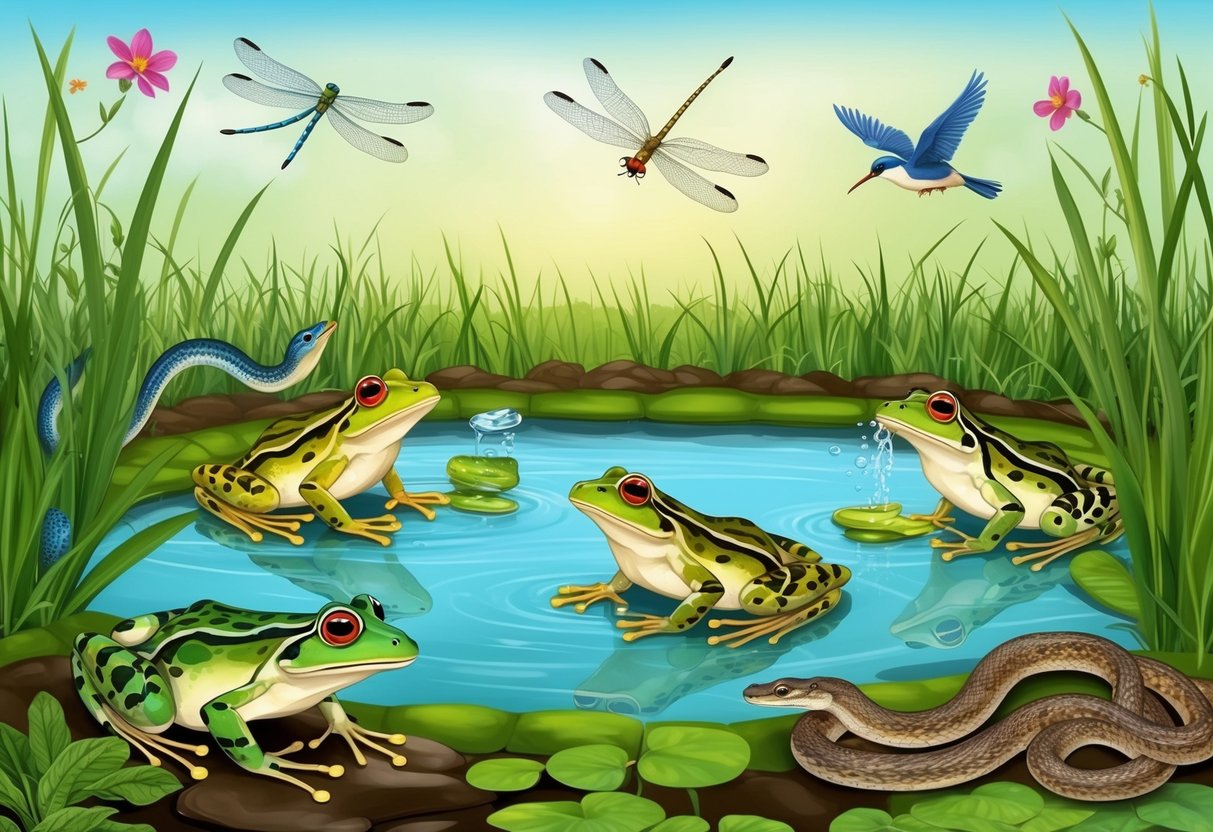
A frog pond brings more than just frogs to your garden. It creates a mini-ecosystem that attracts various helpful creatures. These animals work together to keep pests in check naturally.
Dragonflies
Dragonflies are beautiful insects that help control mosquito populations. They lay their eggs in water, making frog ponds perfect homes for them.
Adult dragonflies can eat hundreds of mosquitoes daily. Their larvae, called nymphs, live in the water and eat mosquito larvae.
Dragonflies also eat flies, gnats, and other small flying insects. This makes them great allies in keeping your outdoor space bug-free.
To attract dragonflies, include some plants around your pond. They like to perch on tall grasses and reeds.
Birds
Many bird species are drawn to frog ponds. They come for water, food, and nesting materials.
Birds like robins, sparrows, and finches eat insects that might harm your garden. They catch flies, caterpillars, and beetles.
Some birds, such as herons, might eat frogs. But they also control rodent populations.
To make your pond more bird-friendly:
- Add shallow areas for birds to bathe
- Plant native trees and shrubs nearby for shelter
- Avoid using pesticides that could harm birds
Birds not only help with pest control but also add beautiful songs to your garden.
Bats
Bats are night-time pest controllers that are often misunderstood. They play a key role in keeping insect populations down.
A single bat can eat up to 1,000 mosquitoes in an hour. They also eat moths, beetles, and other flying insects that come out at night.
Bats are attracted to water sources like frog ponds. They swoop down to drink and catch insects above the water.
To make your garden bat-friendly:
- Leave dead trees standing if safe to do so
- Install bat houses near your pond
- Avoid using bright lights that might scare bats away
Bats also help pollinate plants and spread seeds, making them valuable garden allies.
Amphibians and Reptiles as Pond Visitors
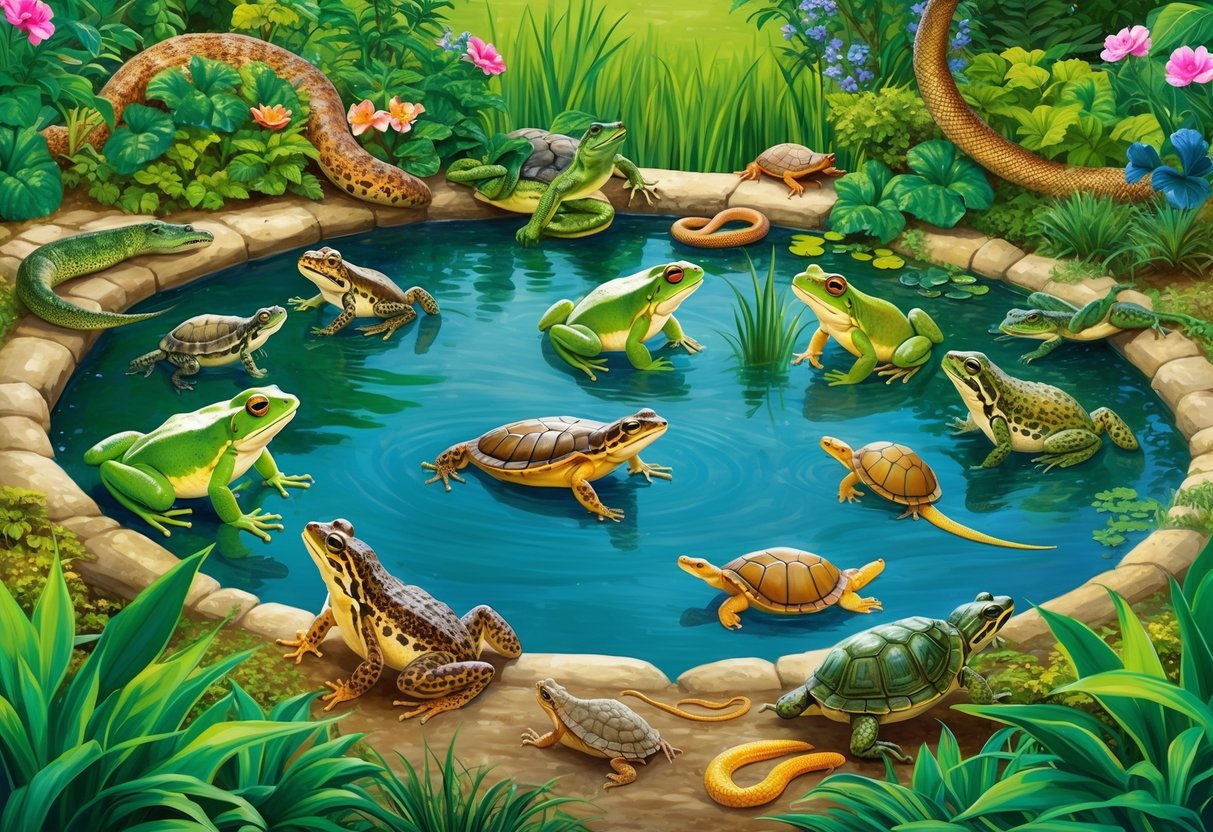
Frogs aren’t the only amphibians and reptiles drawn to ponds. These water features attract a diverse mix of fascinating creatures that add to the pond’s ecosystem.
Salamanders and Newts
Salamanders and newts love damp areas near ponds. They help control insect populations by eating small bugs and worms.
Some salamanders spend their whole lives in water. Others visit ponds to breed. Newts often have a water phase as juveniles, then return to ponds as adults.
These animals need places to hide. Rocks, logs, and plants around the pond’s edge give them shelter. Clean water is key for their sensitive skin.
Turtles
Turtles are exciting visitors to garden ponds. They bask in the sun on logs or rocks, adding interest for pond watchers.
Different turtle species have different needs. Some like to eat plants, while others hunt small fish or insects. A mix of plants and open water suits most turtles.
Turtles need easy ways to get in and out of the water. Sloping sides or ramps help them move around. They also need dry land to lay eggs.
Ponds at least 2m x 2m work well for supporting turtles and other wildlife. Bigger ponds can host more diverse turtle species.
Aquatic Insects Attracted to Frog Ponds
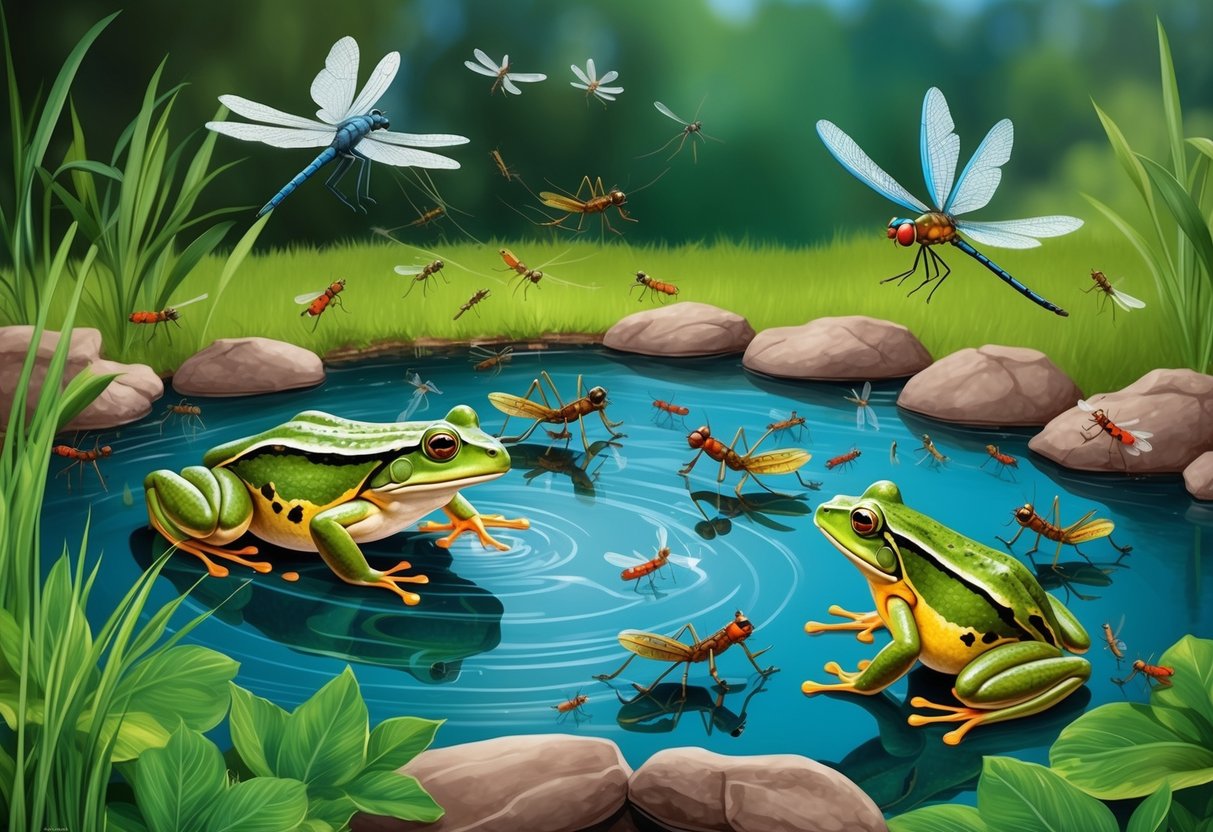
Frog ponds attract many types of aquatic insects. These insects play important roles in the pond ecosystem and serve as food for frogs and other animals.
Water Beetles
Water beetles are common in frog ponds. They come in different sizes and colors. Some water beetles can dive and swim underwater for long periods.
Many water beetles eat algae and dead plant matter. This helps keep the pond clean. Some larger species may hunt small fish or tadpoles.
Water beetles have an interesting life cycle. Their larvae live in the water, while adults can fly to new ponds. This helps spread their population.
Some water beetles can make noise underwater. They do this by rubbing parts of their body together. This sound can attract mates.
Caddisfly Larvae
Caddisfly larvae are fascinating pond insects. They build protective cases around their bodies using materials from the pond.
These cases can be made of:
- Small pebbles
- Bits of leaves
- Tiny sticks
- Sand grains
Caddisfly larvae help clean the pond. They eat algae and other small bits of plant matter in the water. This improves water quality for frogs and other pond life.
As they grow, caddisfly larvae shed their cases and build new, larger ones. This process happens several times before they become adults.
Adult caddisflies look like small moths. They often swarm near ponds at night, providing food for bats and night-flying birds.
Mammals That Benefit From Frog Ponds
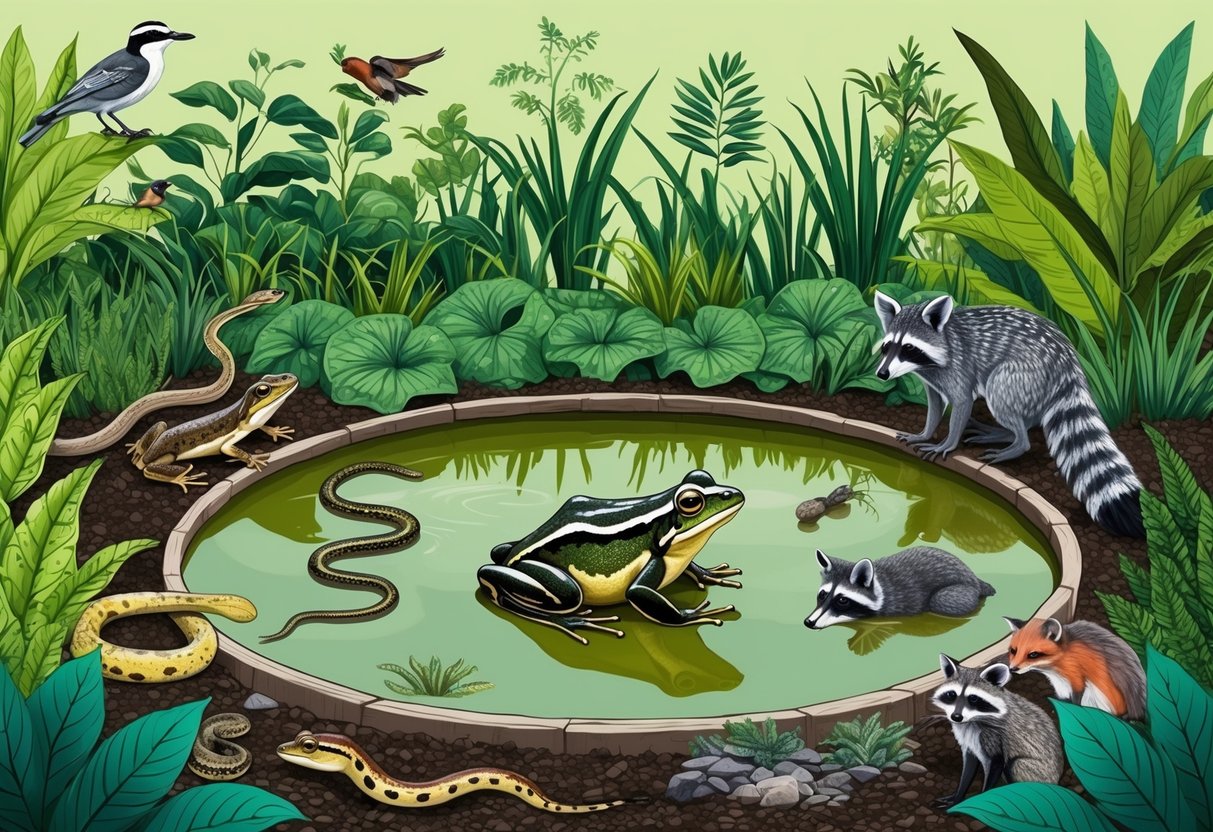
Frog ponds attract a variety of mammals seeking food and water. These animals play important roles in the local ecosystem and can be fun to watch.
Raccoons
Raccoons love frog ponds. They visit at night to hunt for frogs, tadpoles, and other pond creatures. Their hand-like paws help them catch slippery prey in the water.
Raccoons also drink from frog ponds. The water gives them a place to wash their food. This habit makes people think raccoons “wash” their meals.
Frog ponds offer raccoons a cool spot to beat the heat in summer. They may splash around or take a dip on hot days.
While raccoons can be pesky in some ways, they help control insect and rodent populations. This makes them good for the local environment.
Otters
Otters are playful mammals that thrive near frog ponds. They eat frogs, fish, and other small water animals. Their sleek bodies and webbed feet make them great swimmers.
Frog ponds give otters a safe place to rest and play. They often build dens nearby, using pond plants for bedding.
Otters help keep frog populations in check. This balance is good for the pond ecosystem. Their poop, rich in nutrients, feeds plants around the pond.
People enjoy watching otters slide and swim. Their fun antics make them popular visitors to frog ponds. Otters can live up to 20 years, so they may become long-term pond residents.
Beneficial Plants Near Frog Ponds
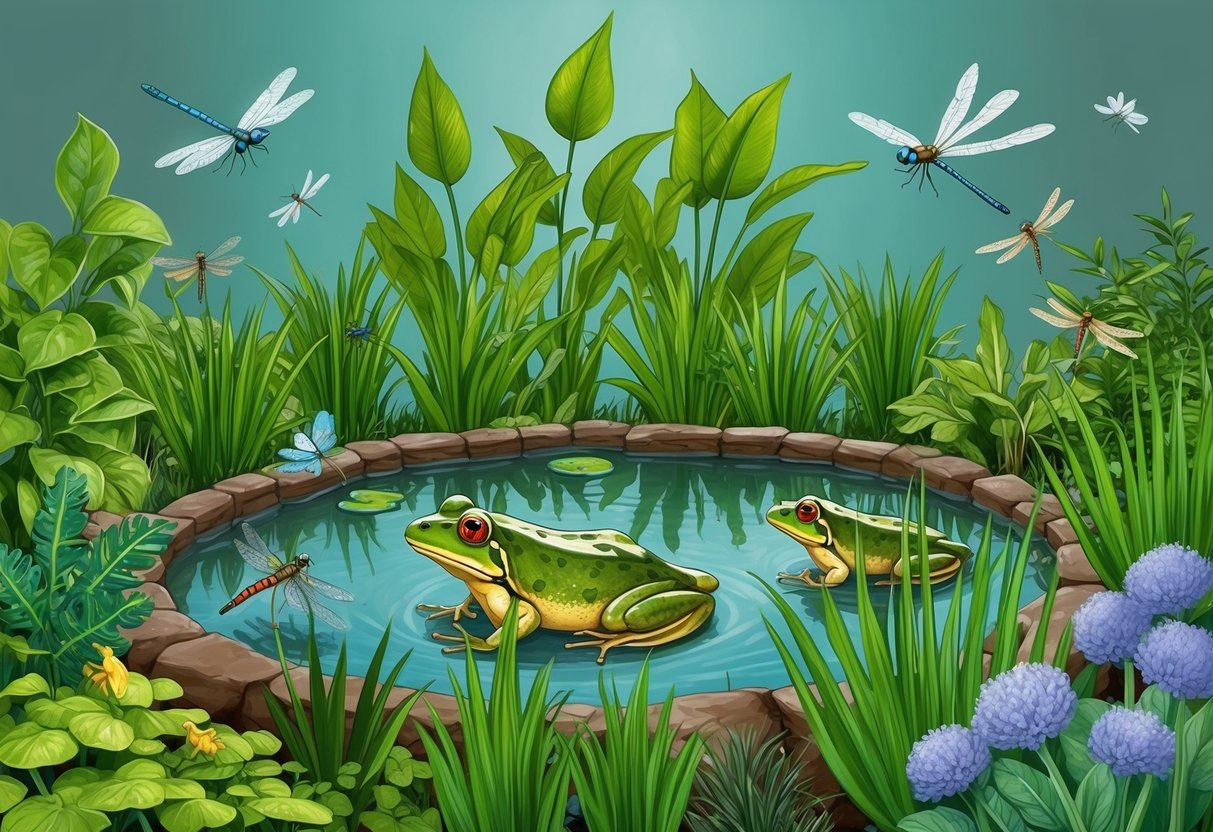
Plants near frog ponds help create a safe home for frogs. They give frogs food and places to hide. Some plants also keep the water clean.
Water Lilies
Water lilies are great for frog ponds. They give frogs a place to rest and hide from birds. Frogs can sit on the big, flat leaves that float on the water.
Water lilies also help keep the pond water clean. They stop algae from growing too much. This makes the water better for frogs to live in.
Frogs can lay their eggs on water lily stems. The flowers attract bugs, which frogs like to eat. Water lilies come in many pretty colors, making the pond look nice too.
Cattails
Cattails are tall plants that grow at the edge of ponds. They’re very helpful for frogs. Cattails make good hiding spots for frogs when they’re on land.
Frogs can climb up cattails to catch bugs. The plants also clean the water by soaking up extra nutrients. This keeps the pond healthy for frogs.
Cattails give frogs a place to lay their eggs too. The leaves offer shade, which keeps the water cool on hot days. This is good for tadpoles as they grow.
Conclusion: The Role of Frog Ponds in Local Ecosystems
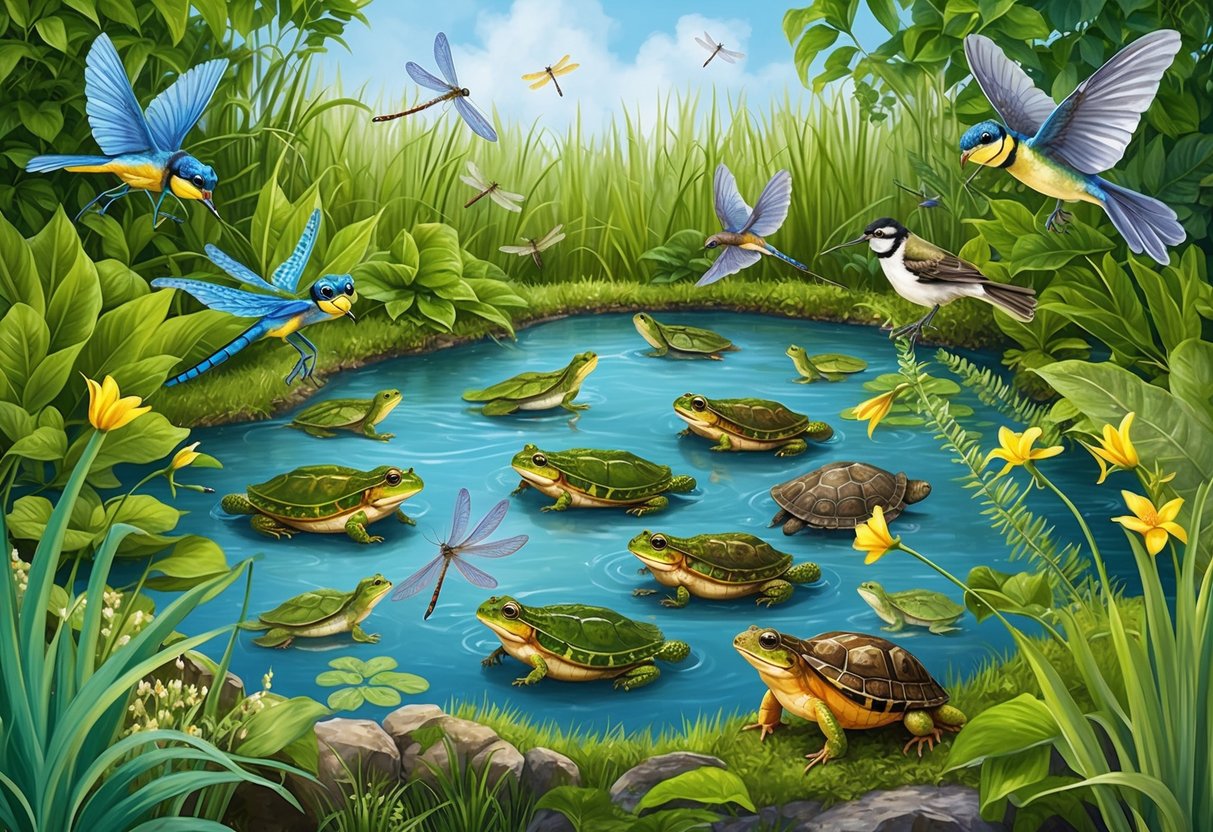
Frog ponds are vital hubs of biodiversity in local ecosystems. They provide a home for frogs and many other creatures.
These ponds attract a wide range of animals. Birds, insects, and small mammals all benefit from the resources frog ponds offer.
Frogs play a key role in keeping the ecosystem balanced. They eat pests like mosquitoes and serve as food for other animals.
Frog ponds also help clean water naturally. Plants and microorganisms in the pond filter out pollutants.
Creating a frog pond is an easy way to support local wildlife. Even a small pond can make a big difference.
Frog ponds connect different habitats. They form stepping stones for animals to move between larger areas.
By making a frog pond, people can help protect endangered species. Many rare frogs and other animals rely on these small water bodies.
Frog ponds bring nature closer to home. They allow people to observe and learn about local wildlife right in their own backyards.
Frequently Asked Questions
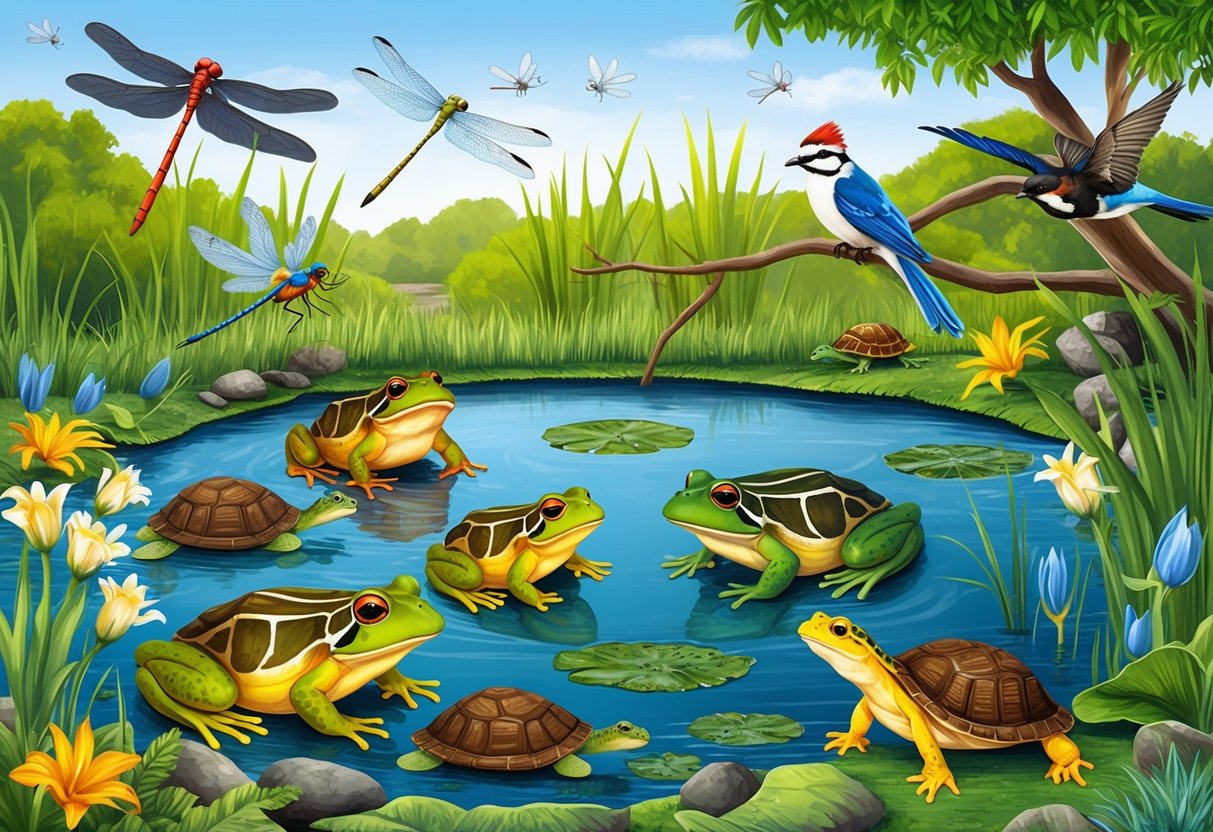
Frog ponds attract a variety of wildlife and play a key role in boosting local biodiversity. Creating the right habitat with suitable plants and safety measures helps ensure a thriving ecosystem.
What types of wildlife can you commonly find in and around frog ponds?
Frog ponds are home to more than just frogs. You’ll often spot dragonflies, damselflies, and water striders skimming the surface.
Birds, small mammals, and reptiles may visit to drink or hunt. Turtles and newts might take up residence if conditions are right.
Can establishing a frog pond in my yard help increase local biodiversity?
Yes, a frog pond can greatly boost local biodiversity. It provides a habitat for amphibians, insects, and other small creatures.
This attracts larger animals like birds and mammals, creating a mini-ecosystem. A well-designed pond supports a food web and offers shelter for various species.
Which plants are most beneficial to include around a frog habitat for ecological balance?
Water lilies are excellent for frog ponds. They provide shade, resting spots, and attract insects for frogs to eat.
Native aquatic plants like hornwort and elodea help oxygenate the water. Ferns and other moisture-loving plants around the edges create shelter and maintain humidity.
What measures can be taken to ensure a frog pond remains a safe haven for amphibians?
Avoid using chemicals in or near the pond. Create gently sloping sides for easy access in and out of the water.
Provide plenty of hiding spots with rocks, logs, and plants. Keep the water clean and use a filter if needed, but avoid strong currents that might harm tadpoles.
What are the signs that a frog pond is thriving and supporting a healthy ecosystem?
Clear water and a variety of plant life are good indicators. The presence of different frog species and their calls is a positive sign.
Spotting tadpoles, dragonfly nymphs, and other small aquatic creatures shows a balanced ecosystem. Birds and other wildlife visiting regularly also suggest a healthy pond.
How can I encourage a diverse range of species to visit my frog pond environment?
Create varied habitats around the pond. Add a mix of sun and shade areas.
Include shallow and deep sections in the pond. Plant different types of vegetation to attract various insects.
Place logs or rock piles near the pond to provide shelter for visiting animals.
